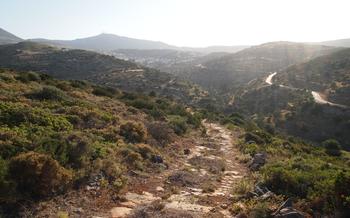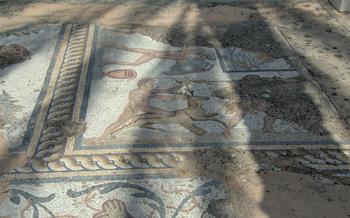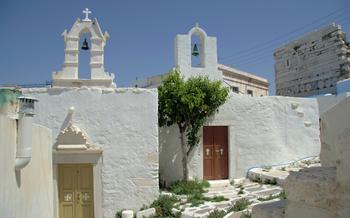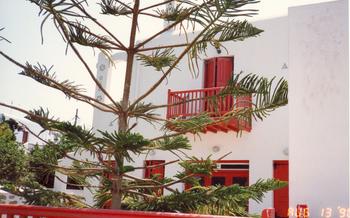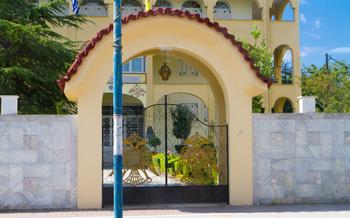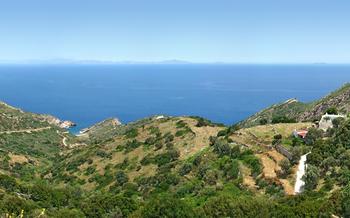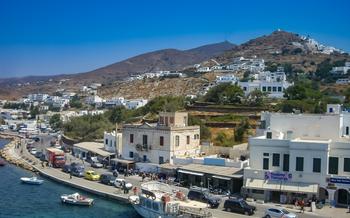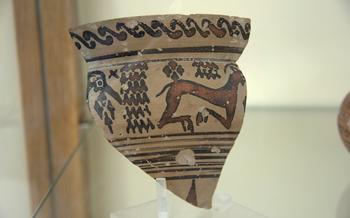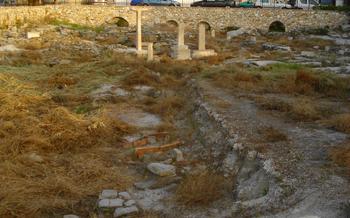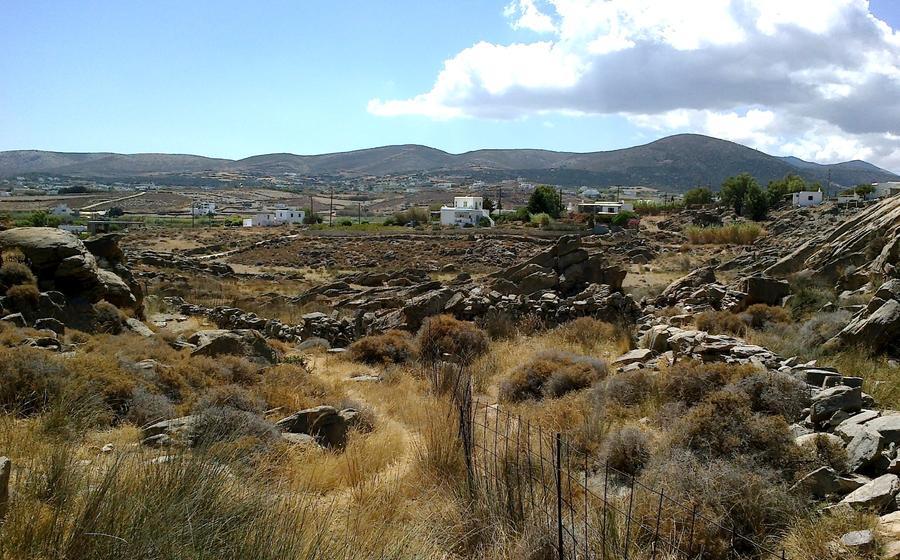
The Mycenaean Acropolis at Koukounaries
- The Mycenaean Acropolis at Koukounaries
- What to expect when visiting the acropolis
- Tips for making the most of your visit
- Historical Significance
- Architectural Features
- Views from the Acropolis
- Exploration and Hiking
- Photography Opportunities
- Visitor Facilities
- Local Cuisine
- Cultural Events
- Nearby Attractions
- Planning Your Visit
- Safety and Security
- Sustainability
- Insider Tip: Unveiling the Ancient Well of Koukounaries
The Mycenaean Acropolis at Koukounaries
The Mycenaean Acropolis at Koukounaries is an ancient citadel perched atop a hill overlooking the picturesque bay of Naousa on the Greek island of Paros. This enigmatic site, dating back to the Bronze Age (circa 1600-1100 BC), stands as a testament to the advanced civilization of the Mycenaeans, who played a pivotal role in shaping the cultural and historical landscape of ancient Greece.
To reach this hidden gem, visitors can embark on a scenic coastal drive from the main port town of Parikia, followed by a short hike up the hill. The journey itself is an adventure, offering breathtaking views of the glistening Aegean Sea and the verdant slopes of Paros. Upon arrival at the acropolis, visitors are greeted by a sight that transports them back in time.
What to expect when visiting the acropolis
The Mycenaean Acropolis at Koukounaries is a place of awe-inspiring beauty and historical significance. As you step through the ancient gates, you will be struck by the sheer size and grandeur of the cyclopean walls, constructed from massive blocks of stone without the use of mortar. These fortifications, once impenetrable, served to protect the acropolis from enemy attacks.
Within the walls, you will discover a fascinating array of archaeological treasures, including the remains of a Mycenaean palace, workshops, storage facilities, and a cistern. These structures provide valuable insights into the daily life, economy, and social organization of the Mycenaean civilization.
Tips for making the most of your visit
To fully appreciate the wonders of the Mycenaean Acropolis at Koukounaries, it is advisable to plan your visit carefully. Here are a few tips to ensure a memorable and enriching experience:
Timing is key: Aim to arrive early in the morning or late in the afternoon to avoid the midday heat and crowds. The golden light of dawn and dusk creates a magical atmosphere, enhancing the beauty of the site.
Wear comfortable shoes: The terrain around the acropolis can be uneven and rocky, so sturdy footwear is essential for navigating the site safely and comfortably.
Bring water and sun protection: The acropolis offers limited shade, so it is crucial to bring plenty of water to stay hydrated and protect yourself from the intense Greek sun.
Consider a guided tour: Guided tours are available at the acropolis, providing expert insights into the history, architecture, and significance of the site. These tours are highly recommended for those seeking a deeper understanding of the Mycenaean civilization.
Historical Significance
The Mycenaean Acropolis at Koukounaries is a site of immense historical significance, providing invaluable insights into the ancient Greek civilization and its origins. During the Bronze Age, around 1600-1100 BC, the Mycenaeans, a powerful and advanced civilization, flourished in Greece. They established fortified settlements known as acropolises, and Koukounaries was one such important center. The acropolis served as a political, administrative, and religious hub for the Mycenaeans, showcasing their architectural prowess and cultural achievements.
Archaeological excavations at Koukounaries have unearthed a wealth of artifacts and structures that shed light on Mycenaean life and culture. These discoveries include impressive cyclopean walls, elaborate buildings, pottery, tools, and religious objects. The acropolis also reveals the Mycenaeans' mastery of engineering and urban planning, as evidenced by the sophisticated water management systems and the strategic location of the site.
The Mycenaean civilization played a pivotal role in shaping the course of Greek history. Their advanced culture, characterized by a centralized government, a written language, and a vibrant artistic tradition, laid the foundation for the subsequent development of classical Greece. The Mycenaeans engaged in extensive trade and cultural exchange with other civilizations, contributing to the dissemination of knowledge and ideas throughout the Mediterranean region.
Ongoing research and excavations at the acropolis continue to provide new insights into the Mycenaean civilization. Archaeologists are meticulously studying the site's architecture, artifacts, and environmental context to reconstruct the daily life, social organization, and beliefs of the Mycenaeans. The Mycenaean Acropolis at Koukounaries stands as a testament to the enduring legacy of this ancient civilization, offering a glimpse into the origins of Greek history and culture.
Architectural Features
The Mycenaean Acropolis at Koukounaries is renowned for its distinctive architectural features, which offer a glimpse into the advanced engineering and construction techniques of the Mycenaean civilization. The most striking feature of the acropolis is its cyclopean walls, constructed using massive blocks of stone without the use of mortar. These walls, some of which stand over six meters high, demonstrate the remarkable strength and durability of Mycenaean architecture.
Within the acropolis, visitors can explore various buildings and structures that served different purposes. The most significant of these is the palace, which was likely the residence of the Mycenaean ruler. The palace features multiple rooms, including a grand hall, storage areas, and living quarters. Other notable structures include a temple dedicated to the goddess Athena, a cistern for water storage, and several workshops where artisans crafted tools, pottery, and other goods.
The architecture of the Mycenaean Acropolis at Koukounaries is not only impressive in its scale and construction but also in its symbolism and religious significance. The cyclopean walls were not just defensive structures but also represented the power and prestige of the Mycenaean rulers. The temple, with its elaborate decorations and offerings, reflects the deep religious beliefs and practices of the Mycenaean people. By studying the architecture of the acropolis, we gain valuable insights into the social, political, and cultural aspects of Mycenaean civilization.
Views from the Acropolis
The Mycenaean Acropolis at Koukounaries offers breathtaking views that will leave you in awe. From the summit of the acropolis, you can feast your eyes on a panoramic vista that encompasses the entire island of Paros and beyond. The deep blue waters of the Aegean Sea stretch out before you, dotted with picturesque islands and shimmering in the sunlight.
The surrounding landscape is a tapestry of natural beauty, with lush green hills, fertile valleys, and sparkling beaches. In the distance, you can spot the iconic whitewashed buildings of the village of Naousa, nestled between two picturesque bays. The acropolis also provides a unique perspective of other significant archaeological sites, such as the ancient city of Delos, which can be seen rising from the sea in the distance.
To truly appreciate the stunning views from the acropolis, it is best to visit during the golden hours of sunrise or sunset. As the sun dips below the horizon, the sky transforms into a canvas of vibrant colors, casting a warm glow over the landscape. The views from the acropolis are not only breathtaking but also offer a profound sense of tranquility and connection to the past.
Exploration and Hiking
The Mycenaean Acropolis at Koukounaries offers a fantastic opportunity for exploration and hiking. Well-marked trails and paths wind through the surrounding landscape, inviting visitors to discover hidden corners of the acropolis and immerse themselves in the natural beauty of Paros. Along the way, hikers can encounter a diverse array of flora and fauna, including fragrant wildflowers, ancient olive trees, and soaring birds of prey. The combination of history and nature makes for a truly unforgettable experience, allowing visitors to connect with the past while appreciating the beauty of the present. Whether you're an experienced hiker or simply looking for a leisurely stroll, the Mycenaean Acropolis and its surroundings offer something for everyone.
Photography Opportunities
The Mycenaean Acropolis at Koukounaries is a photographer's paradise, offering a wealth of stunning views, architectural wonders, and artifacts that are just begging to be captured on camera. The sprawling ruins, set against the backdrop of the Aegean Sea, create a picturesque panorama that will take your breath away. Whether you're a seasoned professional or an amateur enthusiast, the acropolis has something for everyone.
With its dramatic vistas, the acropolis provides ample opportunities to capture sweeping shots of the surrounding landscape. The panoramic views from the top of the acropolis are nothing short of breathtaking, allowing you to capture the vastness of the Aegean Sea and the neighboring islands. Every angle you turn reveals a new perspective, making it easy to snap stunning shots that will leave your followers in awe.
Beyond the breathtaking views, the acropolis itself is a treasure trove of photographic subjects. The ancient architecture, with its imposing cyclopean walls and well-preserved buildings, offers a glimpse into the past and provides a unique backdrop for your photos. Capture the intricate details of the stonework, the weathered facades, and the remnants of Mycenaean civilization that have stood the test of time.
Don't forget to turn your lens towards the Mycenaean artifacts that have been unearthed at the site. From pottery and tools to jewelry and religious objects, these artifacts provide tangible evidence of the lives and culture of the Mycenaeans. Whether you're interested in close-up shots of the intricate designs or wider angles that showcase their historical significance, the artifacts at the acropolis are sure to add depth and interest to your photographic collection.
With so many photo-worthy subjects to choose from, the Mycenaean Acropolis at Koukounaries is an ideal destination for photographers of all levels. So pack your camera, unleash your creativity, and capture the essence of this ancient wonder through the lens.
Visitor Facilities
The Mycenaean Acropolis at Koukounaries is equipped with a range of visitor facilities to enhance your experience. A well-curated museum located at the foot of the acropolis provides an insightful introduction to the history and significance of the site. Here, you can delve into the artifacts unearthed during excavations and gain a deeper understanding of the Mycenaean civilization.
For those seeking a more immersive experience, guided tours are available, led by knowledgeable experts who can provide fascinating insights into the acropolis and its role in ancient Greek history. These tours offer a personalized and informative journey, allowing you to uncover the secrets of this awe-inspiring site.
Educational programs are also offered, catering to visitors of all ages. These programs aim to engage and educate participants about the Mycenaean civilization through interactive activities, hands-on workshops, and storytelling sessions. Whether you're a history buff, an archaeology enthusiast, or simply curious about the past, these programs provide a unique and enriching experience.
The acropolis is designed to be accessible to visitors of all abilities. Well-maintained paths and ramps allow for easy navigation throughout the site, ensuring that everyone can enjoy the wonders of the acropolis.
Local Cuisine
In addition to exploring the historical wonders of Koukounaries, visitors can indulge in the culinary delights of Paros. The island is renowned for its fresh, local ingredients and traditional Greek dishes. Be sure to sample mouthwatering specialties such as dakos, a refreshing salad made with barley rusks, tomatoes, feta cheese, and capers; moussaka, a hearty casserole of eggplant, potatoes, ground beef, and béchamel sauce; and souvlaki, grilled skewers of meat or fish served with pita bread and tzatziki sauce.
For a truly authentic experience, venture into the picturesque villages surrounding Koukounaries. Here, you'll find charming tavernas and restaurants serving up traditional Greek cuisine in a warm and welcoming atmosphere. Be sure to try local delicacies like xtapodi stifado, a tender octopus stew; pastitsio, a baked pasta dish with minced meat and béchamel sauce; and amoglanos, a sweet almond cake flavored with orange zest and cinnamon.
The use of fresh, locally sourced ingredients is a hallmark of Paros cuisine. From the succulent seafood caught in the island's crystal-clear waters to the ripe fruits and vegetables grown in the fertile soil, every dish is a testament to the bounty of the land.
Cultural Events
Paros is not only rich in archaeological treasures but also in cultural traditions and events. Throughout the year, the island hosts various festivals and celebrations that showcase its unique heritage. In the summer months, the island comes alive with music, dance, and art performances. Traditional Greek dances, such as the lively "syrtaki," fill the streets, and local musicians entertain visitors with their soulful melodies.
One of the highlights of the cultural calendar is the Paros Wine Festival, held annually in July. This vibrant event celebrates the island's renowned viticulture, with wine tasting sessions, traditional food, and live music. Visitors can sample a variety of local wines, learn about the winemaking process, and enjoy the lively atmosphere of the festival.
For those interested in history and archaeology, the Paros Archaeological Museum hosts regular exhibitions and events. These exhibitions showcase the island's rich past, from the ancient Cycladic civilization to the Byzantine era. Visitors can learn about the fascinating history of Paros through interactive displays, artifacts, and guided tours.
Participating in cultural events in Paros is a fantastic way to immerse oneself in the island's vibrant traditions and connect with the local community. Whether it's dancing to traditional music, savoring local delicacies at a food festival, or exploring the island's history at a museum, visitors are sure to create lasting memories and gain a deeper appreciation for the rich cultural heritage of Paros.
Nearby Attractions
The Mycenaean Acropolis at Koukounaries is just one of many historical and cultural treasures to be found on the island of Paros. In close proximity to the acropolis, visitors can explore a wealth of other significant archaeological sites and attractions.
Just a short boat ride away lies the island of Delos, a UNESCO World Heritage Site and one of the most important archaeological sites in Greece. Delos was once a major religious and commercial center in the ancient world, and its ruins offer a glimpse into the rich history and culture of the Aegean civilization.
Back on Paros, the town of Naousa is a must-visit for those interested in Venetian architecture. The town's picturesque harbor is lined with colorful buildings, narrow streets, and charming shops, creating a unique and atmospheric ambiance.
Beyond these specific attractions, the island of Paros itself is steeped in history and culture, with numerous churches, monasteries, and traditional villages to explore. Visitors can immerse themselves in the local way of life, sample delicious Greek cuisine, and discover the island's hidden gems, creating a truly memorable and enriching travel experience.
Planning Your Visit
To make the most of your visit to the Mycenaean Acropolis at Koukounaries, careful planning is essential. The best time to visit is during the shoulder seasons, spring (April-May) and autumn (September-October), when the weather is pleasant, and the crowds are smaller. Summer months (June-August) can be hot and crowded, while winter (November-March) can bring unpredictable weather conditions.
Visiting early in the morning or late in the afternoon is recommended to avoid the midday heat and capture the most stunning light for photography. Guided tours led by experienced historians or archaeologists are available for those who prefer a more in-depth exploration of the site. Alternatively, self-guided exploration is possible using the well-marked trails and information panels.
Comfortable shoes are a must, as the terrain can be uneven and rocky. Don't forget to bring water, as there are no facilities for refreshments on the acropolis. Sunscreen, a hat, and sunglasses are also essential for protection against the strong Greek sun.
Safety and Security
The Mycenaean Acropolis at Koukounaries is a safe and secure place to visit. The site is well-maintained and patrolled by security personnel, and there is a strong sense of community in the area. However, as with any tourist destination, it is important to be aware of your surroundings and take necessary precautions to ensure your safety.
Here are a few tips for staying safe while exploring the acropolis:
- Be aware of your surroundings and keep an eye on your belongings.
- Avoid walking alone at night, especially in secluded areas.
- Wear comfortable shoes and clothing, as the terrain can be uneven and slippery.
- Bring water and sunscreen, as there is limited shade on the acropolis.
- Follow the marked trails and paths, and avoid exploring off-trail areas.
- Be respectful of the site and its cultural significance.
By following these simple tips, you can help ensure that your visit to the Mycenaean Acropolis at Koukounaries is a safe and enjoyable one.
Sustainability
In the spirit of responsible travel, it's essential to minimize your environmental impact while exploring the Mycenaean Acropolis at Koukounaries. Consider using eco-friendly transportation options, such as bicycles or electric vehicles, to reach the site. Once there, stay on designated trails to prevent damage to the surrounding vegetation. Avoid littering and dispose of waste properly in designated bins. By embracing sustainable practices, you can help preserve this ancient site for future generations while enjoying its historical and natural wonders.
Insider Tip: Unveiling the Ancient Well of Koukounaries
Beyond the captivating ruins and stunning views, the Mycenaean Acropolis at Koukounaries holds a hidden gem that often goes unnoticed by visitors. Concealed amidst the archaeological wonders lies an ancient well, believed to date back to the same era as the acropolis itself. While its exact purpose remains a mystery, some speculate that it served as a vital water source for the inhabitants of the acropolis.
To discover this hidden gem, venture off the main path and follow a discreet trail that leads to a secluded spot. There, nestled amidst overgrown vegetation, you will find the ancient well. Its weathered stone walls and timeworn appearance transport you back to a bygone era, evoking a sense of awe and wonder.
As you gaze upon the well, imagine the hands that drew water from its depths centuries ago. Perhaps it was used by the Mycenaean warriors to quench their thirst after a long day of defending their city. Or maybe it provided sustenance to the women and children who called the acropolis home. Whatever its purpose, the well stands as a testament to the ingenuity and resilience of the Mycenaean people.
So, if you seek an off-the-beaten-path experience at the Mycenaean Acropolis at Koukounaries, be sure to uncover the hidden treasure of the ancient well. It offers a unique glimpse into the daily lives of the ancient Greeks and adds a touch of mystery and intrigue to your exploration of this remarkable site.
